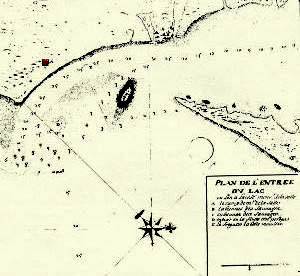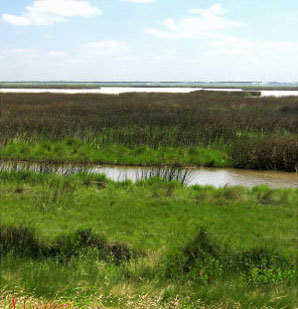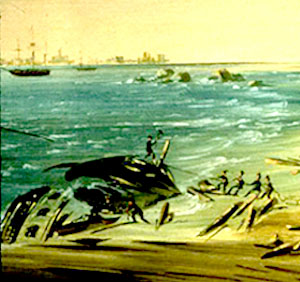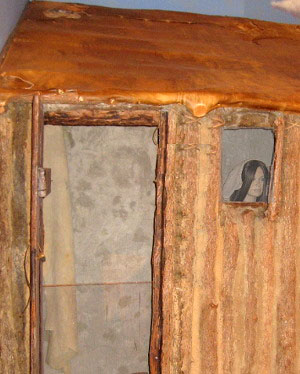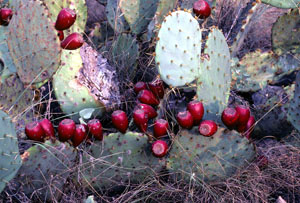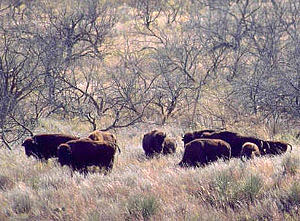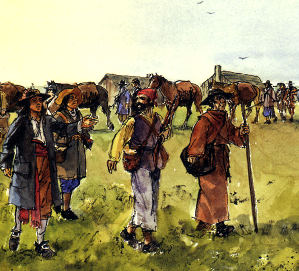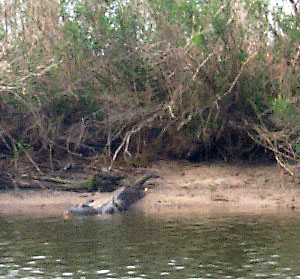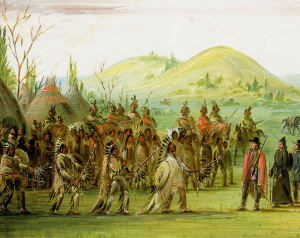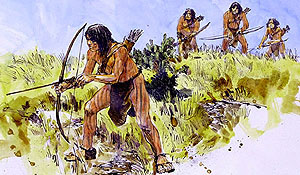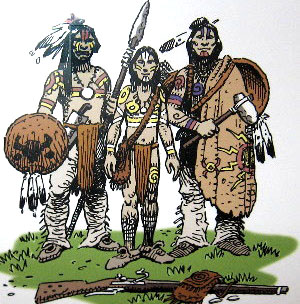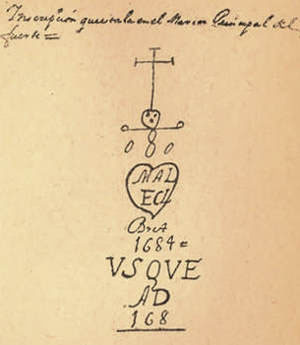Life . . . and Death in the French Settlement
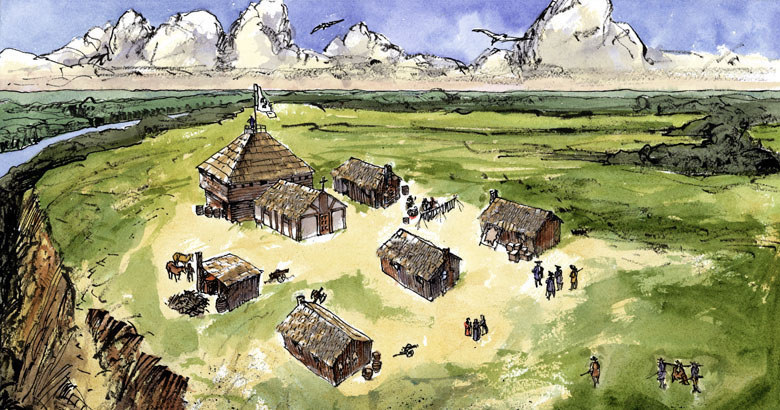
Situated on a high point on the banks of Garcitas Creek, the small French settlement later to be known as Fort St. Louis consisted only of a two-story building made of salvaged ship timbers, a chapel, and some small jacal structures. Crudely built with roofs of thatch, the huts offered little protection from the natural elements and even less from the Karankawa. Illustration by Charles Shaw (from Bruseth and Turner 2005; courtesy of the Texas Historical Commission). |
|
Once La Salle had settled on the site for his temporary colony, the major undertaking became moving people and property from “Grand Camp” on Matagorda Island. La Salle remained at the new site on the Rivìere aux Boeufs (River of Beefs; modern-day Garcitas Creek). In early June 1685, Grand Camp was vacated except for Joutel and thirty men. They were to load the remaining property on the Belle,which was to be unloaded near the mouth of Lavaca Bay and taken then by canoe or the Belle’s shallop. Seventy colonists, meanwhile, undertook a grueling 50-mile march up the west shore of Matagorda Bay. This group included Madam Talon and her 10-month-old baby, Robert, born during the crossing. The mother had her two daughters, ages 12 and 13, to relieve her of carrying the infant. The toddler Lucien, age 3, trotted alongside, aided by his two older brothers, who were 6 and 10. (No mention is made at this point of Lucien Talon pére.) There were also six girls or young women, at least some of whom had been taken from the brothels of Paris. Otherwise, the procession was made up of young men and boys: tradesmen, soldiers, and service personnel, as well as adventurers who had come seeking opportunity in the new land. No account survives of this long walk, but the people surely had to take wide detours around bayous and snake-infested marshes, often wading, constantly in dread of Indian attack. Arriving at their new home, on a bluff overlooking the Rivìere aux Boeufs, they found little comfort. Joutel, who reached the place by canoe in July, found the only shelter to be a staked enclosure where the powder was kept. Disappointed at the lack of progress, he saw dry and sterile seedbeds, unprotected from the rooting and trampling of swine; everything in “a miserable state.” Illness and death were everywhere. The Struggle for ShelterHousing was the urgent need. The nearest suitable timber for building was a league away; there were no carts or draft animals to move it. La Salle, nevertheless, put men to work felling trees and squaring logs while others stood guard against Indians. At first, men dragged the timbers over the three miles to the building site, a near impossible feat that overcame even the strongest. Then a gun carriage was employed, but it, too, was difficult to move through the tall, matted grass. La Salle, distressed that the effort did not succeed as he wished, became ill-tempered and abusive. Joutel later wrote, “I can testify that [this work] caused the death of more than thirty people, as much from the punishment they received as from the affliction.” Whereas La Salle himself acknowledged the loss of half his people within less than six months after his arrival on the Texas coast, he blamed the men themselves. Incapable of discipline, he alleged, they took unto themselves the means of their own destruction. At last Joutel was permitted to return to Grand Camp to build a raft for transporting l’Aimable’s salvaged timbers, which proved more useful than all the logs brought from the woods at such a heavy cost. A house with four rooms was built in the Canadian style, the thin planks used as roof decking and covered with bison hides. One of the rooms was La Salle’s lodging; another for the Récollet fathers; the third for some of the gentlemen volunteers, the fourth for storage. The rest of the people, Joutel related, were “almost without shelter.” Such was the lack of consideration accorded the rank-and-file colonists, who are seldom mentioned in Joutel’s journal. Assigned to keep the official record, he assiduously prevented others from writing. Two factors influenced the content of his account: his loyalty to La Salle that prevented his writing anything that might be disagreeable to the leader; and his military training that led him to consider only persons of rank. In consequence, much is suppressed. Natural forces conspired to diminish numbers in the small settlement. One of La Salle’s key officers died from gangrene, the result of an infected wound caused by a snakebite. The Sieur Le Gros had stepped on a rattlesnake while hunting at Grand Camp. Amputation, performed by the surgeon, was not successful, and sealed his fate. Prowling Indians kept the colonists on edge, and La Salle ordered his men to fire at them on sight. A state of warfare had existed ever since a deadly confrontation arose from the Indians pillage of the Aimable’s stores that had washed ashore and the Frenchmen’s seizure of native canoes. During the building of the settlement, Indians approached in threatening posture several times but were always put to flight. Then a band of fourteen Karankawas attacked three men who had gone out hunting. In danger of being overcome, one of the men, with a lucky shot, killed a chief; the Indians withdrew. With the settlement fairly well established, La Salle planned to board the Belle to seek a way to the Mississippi, still believing a branch of the big river emptied into the bay complex where he had placed the people. Intending to move his colony to the Mississippi when he found it, he loaded the Belle with provisions the colonists depended on for their existence, even to a litter of six-week-old pigs. Then, leaving Joutel in charge of the post, he departed on the last day of October 1685. In typical La Salle fashion, he soon allowed a host of diversions to keep him from his purpose. First, he pursued a band of marauding Indians to their village, where he found artifacts suggesting Spanish presence in the area. Back at his camp near the ship, La Salle found some of his men had died from eating prickly-pear tunas without removing the tiny thorns. He ordered the Belle’s captain to begin sounding a channel for entering Lavaca Bay, while he and his men explored the bay’s perimeter. Returning toward the ship in late December, he came upon the bodies of the sounding party—the ship’s captain and five others—all slain by Indians. Leaving the bibulous Tessier in command of the Belle, La Salle, with 20 men, departed early in January on a mysterious journey to the west, apparently seeking knowledge of the Spaniards and their mines. During La Salle’s long absence from the post, lodging was built for the soldiers and workmen and for the women and girls. Trees were cut farther up the Rivière aux Boeufs and brought by boat a few at a time when hunting trips were made. Walls were of logs or stakes, placed side by side on end and plastered with clay mixed with a lighter top soil to prevent cracking. Roofs were thatched with reeds that grew along the streams. Somewhat later, plans were made to erect a palisade, or fence, around the settlement for protection, but the necessities of daily living intervened; the palisade was never built. Joutel, when left in charge, confronted both the environmental strangeness and the lack of provisions. The colonists were without meat, as the entire supply had been placed on board the Belle. Their sustenance consisted of a daily bread ration and an occasional helping of soup made from a piece of salt pork and doled out sparingly. Hunting and GatheringFood became more readily available as hunting skills improved. Whereas the buffalo, or bison, became the staple, other game animals and birds rounded out the fare. There were deer, turkeys, prairie chickens, waterfowl, and various shore birds. When the bison herds came near the camp, Joutel assembled his best marksmen, but none knew anything about hunting the shaggy beasts. Joutel himself fired time after time into the herd, breaking the shoulder of several animals without bringing one down. The huntsmen crawled on hands and knees to get within range, only to have the animals catch their scent and scatter. At the end of a long and tiring day, his knees raw from crawling, Joutel came upon the still-warm carcass of an animal that had fallen out of his line of vision. The butchering extended the day well into the night, for no one had experience. Gradually, the men developed their skills, and there was plenty of meat. Still, it was not the end of difficulties on the hunt. Both Father Anastase Douay and Father Zénobe Membré suffered crippling accidents when charged by a wounded buffalo. In each instance, the clerical robe impeded flight, and both fathers were trampled severely. There were other accidents, from different causes. Father Maxime Le Clercq was attacked by a boar. The vicious beast gnashed his arm, severing tendons and rendering his fingers useless. It was Pére Maxime’s misfortune also to become lost; he spent a cold night in the open before finding his way back to the settlement. One of the girls, after helping the hunters dress the kill, was left behind and spent two nights alone in the wilderness. It is said that Lucien Talon pére, father of the six children, had been “lost in the woods” while on a journey with La Salle and was never heard of again. Fear of the Karankawas intensified concern for the lost ones.Sentries were posted at each corner of the house. Indians stalked about the settlement and staked the nearby spring with arrows, signifying their claim and a warning to violators. Around the settlement, trees large enough to obstruct the view were cut down. When long hunting trips were made and the hunters had to make camp for the night, a brush barricade was thrown up so that no one could approach without detection. Joutel, the gardener’s son, observed the native flora and compared or contrasted it to that of Normandy. The temperate climate with “almost no winter” favored the mulberry trees that grew along the stream and produced a fruit that was sweeter, though smaller, than the mulberries of France, as were the wild blackberries. The grapevines that climbed to the treetops produced a fruit that was sharp to the tongue and unsuitable for wine, though the verjuice added zest to soups and stews. Domestic plantings fell short of success at first. When the beans planted in February failed to sprout, it was thought the seed had been wet with sea water during the crossing. Wheat fared no better. Chicory, beets, celery, asparagus, melons, and pumpkins, sewn in scattered plots to test the soil, came up well, but the lack of fences to keep out the pigs doomed the plantings to failure. The post was a happier place when La Salle was absent and Joutel in charge. The surrogate commander, by his own account, strove to maintain an orderly, yet relaxed, routine. Soon, however, La Salle returned from his westward trek to face a dire situation. The Belle was missing and could not be found. The colony was stranded, with no means of carrying out La Salle’s design and no means of escaping this trackless wilderness. La Salle Seeks HelpHis options narrowed, La Salle decided on an overland journey to Canada; from that point he would to send to France for aid. In late April 1686, he chose 20 companions and departed on an eastward course. Joutel again remained in charge of the post. Short of provisions, the surrogate commander was forced to send out huntsmen to look for game, leaving the settlement with few persons to defend it. Everyone had to take a turn at standing sentry; the women and girls, trained in the handling of firearms, soon took their turn as well as the men and boys. A few days after La Salle’s departure, the Abbé Chefdeville and five companions—the only survivors of the 27 men who had been assigned to the Belle—reached the post to report the loss of the ship in a sudden squall. The six were warmly received and fed; Joutel records his regret at the loss of the ship’s cargo but says nothing of the crew. Death of comrades seems to have become the accepted norm. Eventually, Gabriel Barbier would visit the wreck to recover some of the goods. During this time, the colonists undertook various projects for the improvement of their lot but, because of the strangeness of their environment and the exigencies of their daily living, hardly any were completed. A plan to stop roof leaks at the house by covering it with elm bark died with the discovery that the bark would strip from the trees only when the sap was rising. A cellar begun for storing meat never reached completion because of the heavy soil and the lack of workers. It was the same with a plan to erect a log palisade; the few logs gathered finally were used for a less ambitious project. Joutel’s garden plantings on the riverbank somehow escaped the pigs, only to fall prey to rats and rabbits. The several pumpkins that did survive to maturity were consumed by an alligator. A lack of familiarity with the seasons doomed other plantings to failure; cotton planted too late grew well, only to have the plants killed by frost. During the long months without news from the marchers, discontentment spread through the colony. La Salle, it was widely believed, would never return. Pierre Duhaut, who had often played the role of troublemaker, incited the discontent. Joutel, on learning of the plotting, let him off with a reprimand—leniency that he later regretted. Death and DesertionsLa Salle returned in October, having traveled no farther than the Caddoan tribes of eastern Texas. Of the twenty men who had gone with him, only eight returned. Of the other twelve, four had deserted. One man had been pulled down by an alligator while crossing a stream. Five others had become ill and were given leave to return to the colony but never arrived. Seemingly on a more positive note, La Salle brought five horses laden with corn and beans—a temporary benefit outweighed by the dire omen implicit in his return. Before beginning anew, he must take from the already enfeebled colony replacements for the twelve men he had lost. Why indeed had La Salle returned to the settlement when he was already halfway to the Mississippi? He began immediately to plan a new attempt to reach the Illinois post. While he waited for autumn heat to pass, he urged the planting of the seeds he had brought from the Caddoan tribes. Inasmuch as previous plantings had proved fruitless for lack of protection from the pigs, men were detailed to cut stakes for enclosing the garden—one project that actually was completed. Barbier’s hunting party, meanwhile, had a run-in with Indians near the post. The natives withdrew, carrying one warrior, dead or severely injured. Not long afterward, they wrought vengeance on a Frenchman who was gathering firewood scarcely a musket shot from the post, shooting three arrows into his body. As preparations moved forward for his new journey, La Salle chose from the diminishing ranks those who would go and those who would stay, unfortunately choosing the trouble-maker Duhaut as one of his companions. Seventeen men would follow him toward the Mississippi; twenty-three would remain in the charge of Barbier, who had been lamed on La Salle’s earlier march by a thorn in the foot, and who had married one of the young women. Left to guard the settlement, by Abbé Cavelier’s account, were “missionaries, women and children, and the disabled.” The twenty-three and the seventeen, plus five deserters sojourning among the Indians, were all who remained of almost two hundred left with La Salle when the Joly sailed for France. With all in readiness, the Christmas season was observed, the Feast of Kings celebrated with toasts drunk with water; the wine was long since gone. On January 12, 1687, the seventeen men took their leave “from the habitation situated on the Rivière aux Boeufs, near the Baye Saint-Louis”—the ragged and destitute little colony that was never deserving of, and never was given, the name “Fort Saint Louis.” Joutel derides the account of a later writer that a fort was built and put in a state of defense. This, he says was purely imaginary, for “there was only the house . . . , having eight cannon at the four corners, . . .without cannonballs, and . . . when we left there was nothing else in the nature of a fort.” Nor was there when the Indians came. A Brutal EndNo full account exists of life in this meager enclave on the bluff overlooking Garcitas Creek. We know only that the months dragged by without word from the marchers. A year passed, then two. No messenger came; hope faded into hopelessness. Had their been news of La Salle’s “rescue mission,” it would have been more disheartening still, for the leader was dead, shot down by the evil one, Duhaut, the willing instrument of a conspiracy among La Salle’s followers. Duhaut himself was dead, from a falling-out among the conspirators. Following this bloodletting in eastern Texas, Joutel, the Abbé Cavelier, and three others eventually reached France, but too late to send help to the beleaguered colonists. After the Talon children had seen their mother slain, the native women, moved to compassion by their youth, carried them away on their backs while the Indian men finished the slaughter. The women also had taken away Madame Barbier, who had a three-month-old baby at breast, but, when the Indian men returned from the massacre, they killed her. Then the infant, whose given name and gender are not known, was held by a foot, its head bashed against a tree. The other children “were reared and loved by these same savage women . . . as if they were their own. . . .” Discovery by the Spaniards |
|
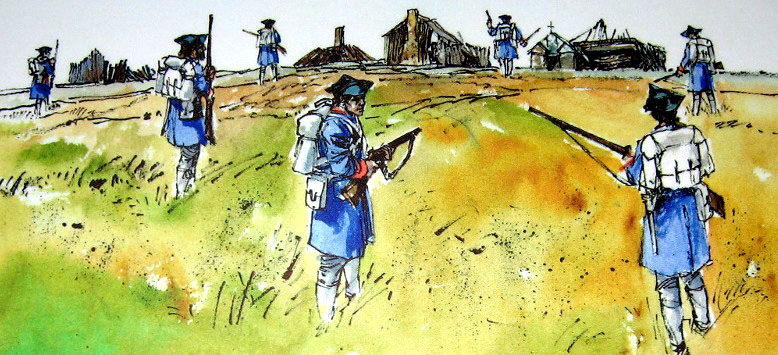 Members of the De Leon expedition find the ruins of the French settlement. Painting by Jack Jackson, in display at the Calhoun County Museum. |
The Spaniards of New Spain, meanwhile, had sought La Salle’s colony for four years, with six land expeditions and five sea voyages. On the bleak and rainy morning of April 22, 1689, General Alonso de León, leading a troop from Coahuila, came upon the ruined settlement. He noted the six houses, the lack of defensive works, and the eight cannons—without cannonballs—which he later buried for archeologists to find, three hundred years later, in the exact same spot. León also mentions a planting of corn and an herb garden of endive and asparagus, enclosed by the picket fence erected during La Salle’s last visit. He found and buried the bodies of three massacre victims. One, with a dress still covering the bones, was that of a woman, the fatal arrow still in her back. From young Talon’s brief account and De León’s description, the dreadful scene of the massacre day may be imagined: the chilling Indian yells; the fearful cries of women and children; the chanted litany of Récollet friar and Sulpician priest; the moans of the dying; and the shrill squeals of pigs as arrows were shot into them too. When no life remained but the swine that scurried off into the wilds, there was the sound of cracking wood, as the Indians smashed furniture and broke off the stocks of the muskets La Salle had brought for the arming of his native allies for the conquest of northern Mexico. Then the Indians in their frenzy tore apart books, and leaves of manuscripts, now rendered illegible, that might have told a more poignant story than can ever be imagined. By the evening’s firelight, the massacre site fresh in mind, Juan Bautista Chapa, the expedition’s historian, composed an elegy of three stanzas. The first stanza addressed the “sad and fateful site.” The final one bespeaks the affront to Spanish sovereignty implicit in the French invasion of territory granted to Spain by the 1494 papal bull of Alexander VI. It is the middle stanza that reveals the writer’s emotions upon finding the three skeletons, especially that of the woman with the fatal arrow still in her back:
On this journey and two others that followed, the Spaniards gathered up the French children—including 12-year-old Pierre Talon who had gone with La Salle and was left among the Hasinai—and took them to Mexico. Also taken were three other young men who had been left by the small group that succeeded in returning to France after La Salle’s murder; these three became settlers in Spanish New Mexico. The Talons, finally repatriated to France, later took part in the exploration and settlement of French Louisiana. Failure of La Salle’s enterprise was written into its very concept: in the unknown geography; in the leader’s confused priorities; and in the blind ambition of others for wealth and status. Yet, despite La Salle’s failure, the results of his endeavor are everlasting. They are seen first in the impetus his intrusion gave to Spanish exploration and settlement of the Gulf region; then the ambitions of France to take advantage of his discovery with settlement of the Mississippi Valley. From these forerunners arose the United States of America as we know it today, forever stamped by the influences of both France and Spain. |
|
